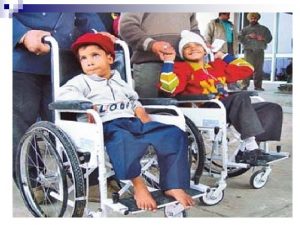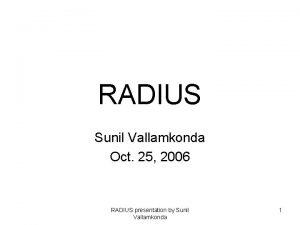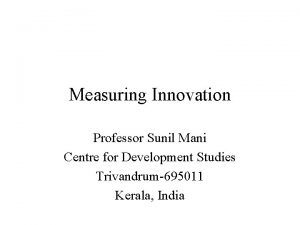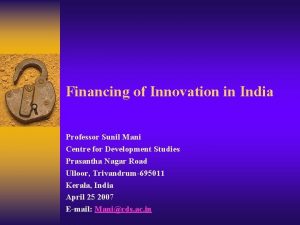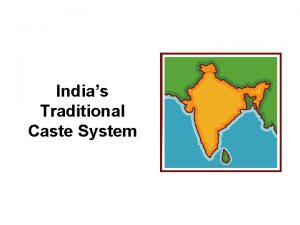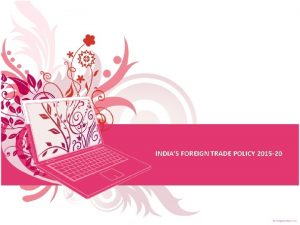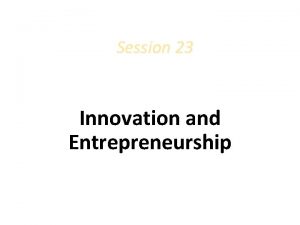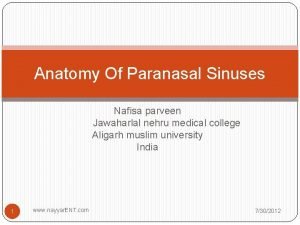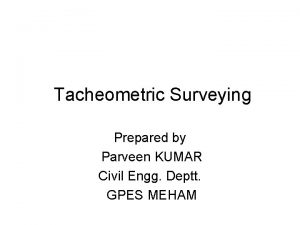Indias Innovation System Sunil Mani and Parveen Arora

























- Slides: 25

India’s Innovation System Sunil Mani and Parveen Arora Sunil Mani, BRICS, Aalborg

Outline l l 2 Performance of India’s Innovation System l R&D Investments (PA) l Patents (SM) l Technology content of exports(SM) l Growth of R&D outsourcing (SM) l Technology import (SM) Components – Overall policy framework (PA) – Physical technological infrastructure (PA) – Financing of innovation (SM) – Supply of scientists and engineers(SM) – Intellectual property right protection (SC) Sunil Mani, BRICS, Aalborg

Relative performance of India wrt Patenting in the USA 3 Sunil Mani, BRICS, Aalborg

Share of local patents in the total number of Indian patents in the USA 4 Sunil Mani, BRICS, Aalborg

Technology-wide distribution of Indian Patents, 1995 -1999 5 Sunil Mani, BRICS, Aalborg

Technology-wide distribution of Indian Patents in the US, 2000 -2004 6 Sunil Mani, BRICS, Aalborg

Technology-wide Distribution of Indian Patents in the USA: Differences between the two sub periods (Sub period 1: 1995 -1999; Sub period 2: 2000 -2004) l l 7 First of all there has been a significant increase in patenting during the second period by almost 370 per cent; Second, the share of the top 15 per cent has increased during the second period to nearly two-thirds from 57 per cent during the first period. Third, Pharmaceutical patents account for a significant share in both the periods, although its share in the top 15 have decreased in the second sub period; and Fourth, as a corollary of the above, the composition of the top 15 has undergone some changes in the second sub period. As against just one IT and electronic technology (including software) class during the first period, there are now 6 such technology classes in the second period. This shows the breadth of patenting by Indian inventors has increased. Sunil Mani, BRICS, Aalborg

Technology content of India’s Exports l l 8 Studies have shown that only about 7 to 8 per cent of India’s manufactured exports can be termed as high tech. Most of it is accounted by pharmaceutical products; But the sustained growth of IT exports is changing the story. IT exports have two variants. The first one is direct IT exports and the second one is indirect IT exports in the form of remittances of knowledge workers; The direct IT exports now account for over 20 per cent of merchandise exports and over 13 per certcent of total exports. Sunil Mani, BRICS, Aalborg

Technology content of India’s Exports 9 Sunil Mani, BRICS, Aalborg

Growth of R&D Outsourcing l l l 10 Two variants R&D outsourcing per se and growing clinical trials. No time series data as the phenomena is very new- just two years old, but on definite growth path Sunil Mani, BRICS, Aalborg

Growth of R&D outsourcing l l l l 11 Evidence of high-end outsourcing is evident from the large number (over 150) established R&D outsourcing centres in India. In fact R&D outsourcing existed even before “outsourcing” became a fad. The R&D story dates back to 1985 -86 when Texas Instruments was the first to set up a center in Bangalore. GE and Intel soon followed suit, as did other global technology and telecom companies like Cisco, Microsoft and Motorola. The trend gained strength as not just large but medium, small and even startups set up research bases in India. The R&D outsourcing market for IT in India is estimated to grow more than $8 billion by 2010 from $1. 3 billion in 2005, at a CAGR of 30 per cent according to some industry estimates. Outsourcing models for R&D vary, from captive to third party to contract assignments. The pioneers of R&D outsourcing were from information technology. R&D centres in the telecom sector came next, and automobiles, pharmaceutical and biotechnology are the emerging areas where R&D outsourcing is bound to increase. This growth of R&D outsourcing brings to our attention two important dimensions. First of all, it shows that if R&D as a profession is incentivised, it is possible for the country to effect considerable increases in its R&D investments. The fact that foreign MNCs are able to establish contract R&D centres is a clear example of this possibility. Second contract R&D centres can be an important learning tool for the contract research organisations to emerge as important manufacturers in the future, provided that government is able to leverage this important opportunity through appropriate policy support. Such a policy support does not exist as of now. Sunil Mani, BRICS, Aalborg

Trends on technology imports to India during the post liberalization period (Number of collaboration agreements) 12 Sunil Mani, BRICS, Aalborg

Payments made for technology import during the post liberalization period does not show any growth 13 Sunil Mani, BRICS, Aalborg

Components of Innovation Policy Overall policy framework 14 Sunil Mani, BRICS, Aalborg

Salient features of the New Innovation Policy of 2003 l Optimal utilisation of existing infrastructure and competence; Strengthening infrastructure for S&T in academic institutions; New funding mechanisms for basic research ; Human resource development; Technology Development, Transfer and Diffusion; Promotion of Innovation; Industry and Scientific R&D; and l Fiscal measures l l l 15 Sunil Mani, BRICS, Aalborg

Public sector allocation to S&T over the Indian five year plans 16 Sunil Mani, BRICS, Aalborg

Composition of Indian R&D personnel (number) 17 Sunil Mani, BRICS, Aalborg

R&D Personnel l 18 Both in absolute number and in density terms the number of R&D personnel in the country is very small; There is an explicit recognition of this fact in the new S&T policy of 2003. In my view it is more of a demand side phenomena. More on this point in my presentation on human resources. Sunil Mani, BRICS, Aalborg

Financing of Innovation l The country has three broad schemes – – – 19 Research grants Tax incentives Venture capital Sunil Mani, BRICS, Aalborg

Research Grants 20 Sunil Mani, BRICS, Aalborg

Research Grants l l l 21 Large number of research grants administered by a plethora of organizations Most grants are targeted at public sector research institutes and enterprises The Matthew effect in grant disbursals owing to the principle of accumulative advantage Sunil Mani, BRICS, Aalborg

Tax Incentives l l l 22 There are five different types of tax incentives; Considerable year to year changes in its scope; Has not very effective in raising R&D investments with the notable exception of pharmaceutical industry. Sunil Mani, BRICS, Aalborg

Venture capital l 23 Venture capital was introduced in 1988; The country has a very vibrant VC industry The investment pattern of the VC industry represented an ideal model in phases I and II but no longer appears to be so. Sunil Mani, BRICS, Aalborg

Indian VC industry in historical perspective 24 l Phase I - Formation of TDICI in the 80’s and regional funds as GVFL & APIDC in the early 90 s. l Phase II - Entry of Foreign Venture Capital funds between 1995 -1999 l Phase III - (2000 onwards). Emergence of successful India-centric VC firms l Phase IV – US VCs’ increasing appetite to invest in India Sunil Mani, BRICS, Aalborg

India Venture Capital Investment Trends Source: IVCA/AVCJ 25 Sunil Mani, BRICS, Aalborg
 Bpwn
Bpwn Parveen
Parveen Indian cast system
Indian cast system Innovation for the sake of innovation
Innovation for the sake of innovation Radical innovation vs disruptive innovation
Radical innovation vs disruptive innovation Indias religions
Indias religions Indias religions
Indias religions What is indias main religion
What is indias main religion Indias first empire
Indias first empire Indias first civilization
Indias first civilization Flota de indias ruta
Flota de indias ruta Que es el real consejo de indias
Que es el real consejo de indias The maurya and gupta empires
The maurya and gupta empires Dr l sunil chandran
Dr l sunil chandran Supply chain management sunil chopra 6th edition ppt
Supply chain management sunil chopra 6th edition ppt Sunil mukhi
Sunil mukhi Sudha chandran leg
Sudha chandran leg Sunil khatri tamu
Sunil khatri tamu Sunil paudel
Sunil paudel Stuart's medium
Stuart's medium Sunil dhola
Sunil dhola Sunil batra nsdl
Sunil batra nsdl Illusion of asymmetric insight
Illusion of asymmetric insight Tactical sunil g
Tactical sunil g Sunil vallamkonda
Sunil vallamkonda Sunil thapar
Sunil thapar
















